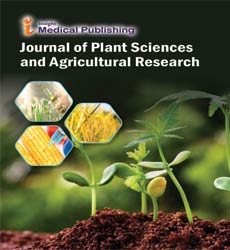Role of Biotechnology in Crop Improvement and Food Security
Paul Trampuz*
Queensland Alliance for Agriculture & Food Innovation, University of Queensland, Queensland, Australia
*Corresponding author:
Paul Trampuz,
Queensland Alliance for Agriculture & Food Innovation, University of Queensland, Queensland, Australia;
E-mail: trampuz.paul@queensland.au
Received date: February 01, 2025, Manuscript No. ipjpsar-25-20849; Editor assigned date: February 03, 2025, 2025, PreQC No. ipjpsar-25-20849 (PQ); Reviewed date: February 15, 2025, QC No. ipjpsar-25-20849; Revised date: February 22, 2025, Manuscript No. ipjpsar-25-20849 (R); Published date: February 28, 2025, DOI: 10.36648/ipjpsar.9.1.170
Citation: Trampuz P (2025) Role of Biotechnology in Crop Improvement and Food Security. J Plant Sci Agri Res Vol: 9 No: 1
Introduction
Biotechnology has become a cornerstone of modern agriculture, revolutionizing the way crops are improved and cultivated to meet the growing global demand for food. With the worldâ??s population projected to exceed nine billion by 2050, ensuring food security while minimizing environmental impacts is a pressing challenge. Biotechnology provides powerful tools to accelerate crop improvement, enhance resilience to biotic and abiotic stresses and improve nutritional quality. Unlike traditional breeding, which relies on slow and often imprecise selection methods, biotechnology offers targeted, efficient and innovative solutions that are essential for sustainable agriculture and global food security [1].
Description
One of the most impactful contributions of biotechnology is the development of Genetically Modified (GM) crops. Transgenic technology allows the insertion of specific genes into plants to confer desired traits such as pest resistance, herbicide tolerance, or improved nutrition. Bt cotton and Bt maize, engineered to resist insect pests, have significantly reduced pesticide use, increased yields and lowered production costs in many regions. Similarly, Golden Rice, enriched with beta-carotene, represents a landmark achievement in using biotechnology to address micronutrient deficiencies that affect millions worldwide. These examples highlight how biotechnology can directly improve both productivity and public health. Recent advances in genome editing, particularly with CRISPR/Cas systems, have transformed the landscape of crop improvement. CRISPR has been applied to create drought-tolerant maize, disease-resistant rice and high-yield soybean varieties. Its simplicity, cost-effectiveness and versatility make genome editing one of the most promising tools for addressing future agricultural challenges, including climate change adaptation and food scarcity [2].
Biotechnology also enhances traditional breeding practices through marker-assisted selection (MAS) and genomic selection (GS). Molecular markers linked to desirable traits enable breeders to select superior plants at early stages of development, reducing the time and cost of breeding cycles. Genomic selection, which uses whole-genome data to predict performance, further accelerates crop improvement, particularly for complex traits such as yield, quality and stress tolerance. These approaches combine the strengths of biotechnology with conventional breeding, resulting in faster and more reliable development of improved crop varieties. Tissue culture and micro-propagation techniques represent another critical application of biotechnology in agriculture. By enabling the rapid production of disease-free, genetically uniform and high-yielding plantlets, tissue culture supports large-scale propagation of important crops such as banana, potato and sugarcane. It also facilitates the conservation of endangered species, the production of hybrids and the recovery of plants from genetic transformation experiments. Such technologies ensure both productivity and biodiversity conservation, contributing to long-term food security [3].
The role of biotechnology extends beyond crop improvement into sustainable agricultural practices. Pest-resistant and stress-tolerant crops reduce dependence on chemical inputs like pesticides and fertilizers, thereby lowering environmental pollution and production costs. Biotechnology also supports bioremediation and biofertilizers, which improve soil health and enhance nutrient availability. By reducing the ecological footprint of farming while ensuring higher productivity, biotechnology contributes to the creation of resilient and environmentally friendly agricultural systems. Global collaborations and policy frameworks are increasingly recognizing the importance of biotechnology in addressing hunger and malnutrition. International organizations, research institutes and universities are investing heavily in biotechnological research to improve staple crops in developing countries. By integrating scientific innovation with capacity-building and equitable access, biotechnology can empower farming communities and support the Sustainable Development Goals (SDGs), particularly those related to zero hunger and climate action [4-5].
Conclusion
Biotechnology has fundamentally reshaped the landscape of agriculture by providing innovative tools to improve crop productivity, nutritional value and resilience against stresses. From genetically modified crops to genome editing, molecular breeding and tissue culture, its applications have transformed both scientific research and field practices. Importantly, biotechnology also fosters sustainability by reducing chemical inputs and conserving biodiversity. As global challenges such as climate change, population growth and resource scarcity intensify, biotechnology will remain indispensable in shaping agricultural systems that are more productive, resilient and equitable, thereby ensuring food security for future generations.
Acknowledgment
None.
Conflict of Interest
None.
References
- Pootakham W, Sonthirod C, Naktang C, Ruang-Areerate P, Yoocha T, et al. (2017). De novo hybrid assembly of the rubber tree genome reveals evidence of paleotetraploidy in Hevea species. Sci Rep 7: 41457.
Google Scholar Cross Ref Indexed at
- Chao J, Wu S, Shi M, Xu X, Gao Q, et al. (2023). Genomic insight into domestication of rubber tree. Nat Commun 14: 4651.
Google Scholar Cross Ref Indexed at
- Yang J, Bi HP, Fan WJ, Zhang M, Wang HX, et al. (2011). Efficient embryogenic suspension culturing and rapid transformation of a range of elite genotypes of sweet potato (Ipomoea batatas Lam.). Plant Sci 181: 701-711.
Google Scholar Cross Ref Indexed at
- Sapakhova Z, Raissova N, Daurov D, Zhapar K, Daurova A, et al. (2023). Sweet potato as a key crop for food security under the conditions of global climate change: a review. Plants 12: 2516.
Google Scholar Cross Ref Indexed at
- Narayanan N, Beyene G, Chauhan RD, Gaitán-Solís E, Gehan J, et al. (2019). Biofortification of field-grown cassava by engineering expression of an iron transporter and ferritin. Nat Biotechnol 37: 144-151.
Open Access Journals
- Aquaculture & Veterinary Science
- Chemistry & Chemical Sciences
- Clinical Sciences
- Engineering
- General Science
- Genetics & Molecular Biology
- Health Care & Nursing
- Immunology & Microbiology
- Materials Science
- Mathematics & Physics
- Medical Sciences
- Neurology & Psychiatry
- Oncology & Cancer Science
- Pharmaceutical Sciences
